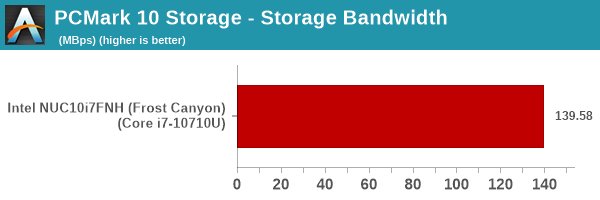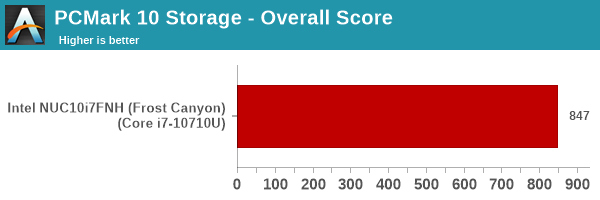Intel NUC10i7FNH Frost Canyon Review: Hexa-Core NUC Delivers a Mixed Bag
by Ganesh T S on March 2, 2020 9:00 AM ESTNetworking and Storage Performance
Networking and storage are two major aspects which influence our experience with any computing system. This section presents results from our evaluation of the storage aspect in the Intel NUC10i7FNH (Frost Canyon). One option would be repetition of our strenuous SSD review tests on the drive(s) in the PC. Fortunately, to avoid that overkill, PCMark 8 and PCMark 10 have storage benches where certain common workloads such as loading games and document processing are replayed on the target drive. Results are presented in two forms, one being a benchmark number and the other, a bandwidth figure.
We first ran the PCMark 8 storage bench on selected PCs and the results are presented below.


The PCIe 3.0 x2 SSD doesn't perform up to the mark when compared to the PCIe 3.0 x4 SSDs used in the other systems. However, it is still better than the SATA SSDs used in other systems. The Frost Canyon NUC is the first one in our SFF PC set to be subject to the PCMark 10 Storage Bench, and as such, we do not have any other systems to compare its average access time of 204 us and storage bandwidth of 139.58 MBps against.



On the networking side, we are yet to set up our 802.11 ax / Wi-Fi 6 testbed for small form-factor PCs, and hence, there are no bandwidth numbers to report yet. However, it must be noted that the Frost Canyon NUC is the first NUC to come with 802.11ax / Wi-Fi 6 support, and its theoretical maximum bandwidth of 2400 Mbps betters the 1733 Mbps offered by the Wireless-AC 9560 in the Bean Canyon NUC. The AX 201 WLAN component uses the CNVi capability in the Comet Lake-U SiP with only the radio being an external chip. The AX 201 has a 2x2 simultaneous dual-operation in 2.4 GHz and 5 GHz bands and also comes with support for 160 MHz-wide channels.










85 Comments
View All Comments
ganeshts - Monday, March 2, 2020 - link
Has been discussed ad-nauseam.If you don't like Bapco's SYSmark, feel free to skip the section.
We believe it presents credible comparison points because it uses *publicly available builds of commercially used software*. The same Adobe applications and MS Office applications are going to be used by consumers whether they have an Intel-based machine or an AMD-based machine.
FWIW, the Frost Canyon numbers in SYSmark actually show that there is no major gains in the benchmark to be had with the addition of the two cores compared to Bean Canyon. Whether people like it or not, most real-world applications fall back on single-threaded performance - Here, Bean Canyon and Frost Canyon are essentially neck-to-neck.
Irata - Tuesday, March 3, 2020 - link
I know this has been discussed a lot, but isn‘t the consensus that it cannot be used as it‘s essentially an Intel sponsored benchmark. I mean nVidia, AMD and Via pulled out for a reason.Also, they have a history of skewing results by stressing certain tasks that feature specific CPU architectures over others going back to the P4 days. Why should this be different now?
James5mith - Monday, March 2, 2020 - link
I have 64GB of RAM in my Bean Canyon NUC running VM's right now. How is this the first one to support it?ganeshts - Monday, March 2, 2020 - link
The keyword is 'officially supported'Max Memory Size is 32GB on this page: https://ark.intel.com/content/www/us/en/ark/produc...
MDD1963 - Monday, March 2, 2020 - link
Pg 1 "... is stil a bit of an unsteady eara" Eara? :)Zok - Tuesday, March 3, 2020 - link
Ugh. Come on! Give me a NUC with 2+ NICs.snowsurferDS - Tuesday, March 3, 2020 - link
The AsRock mini 300 should be tested with a 3400G not a 2400G, at least.dontlistentome - Tuesday, March 3, 2020 - link
Prices keep on going up for no reason (seriously, why should this be so much more epensive than the i7s of a few years ago?).And that power consumption? 64W peak.
next gen the power brick will be bigger than the NUC box.
alpha754293 - Tuesday, March 3, 2020 - link
It's too bad that the thermal management design on these systems are so bad that under heavy CPU and/or CPU+GPU load, it's runs very quickly against the thermal limit, and therefore; has to start throttling itself due to the thermals.If the system had a better thermal management solution and was ACTUALLY able to run at full load for extended period of time, in this form factor, then it would be worth it, else, having a 6-core processor in there is so pointless since you can't even make full use of the previous 4-core CPU in the NUC8.
This is my biggest complaint about my two NUC8s that I have. If it had better thermal management so it wouldn't throttle itself due to thermals, it would present a compelling argument against, for example, the Mac Mini.
ROD.LEE - Tuesday, March 3, 2020 - link
was thinking of upgrading from my NUC8I7BEK, after your review, umm no.